CALL OUR OFFICE
Free Gingival Grafting
Free Gingival Grafting IN SARASOTA & SURROUNDING AREAS
PURPOSE
Gingival recession is defined as a mucogingival deformity and condition that results in exposure of root surface. The main consequences of gingival recession include:
- Root sensitivity
- Esthetic concerns
- Loss of periodontal support
- Increased risk of root decay
If your periodontist has decided that you have no protective zone of attached tissue beneath the root structure, a free gingival graft will be treatment planned.
A free gingival graft is a thin piece of tissue taken from the roof of your mouth to be placed beneath the area of recession. The purpose is to thicken the underlying thin tissue and to prevent future recession.
Procedure Details
- Approximately 1 hour of surgical time with the use of a local anesthetic.
- First, the surgical site is prepared beneath the area of recession called a "bed prep." The overlying thin mucosal tissue is removed to create a blood supply.
- Then, a thin piece of tissue (free gingival graft) is taken from the palate (roof of the mouth) and a double-layer collagen dressing is placed with the use of an adhesive fibrin glue.
- Finally, the free gingival graft is perfectly contoured to fit within the bed beneath the root and sutured in place with resorbable stitches.
- You will return for a post-operative visit in two weeks to check on healing and reinstruct oral hygiene.
Recovery Time
Approximately 2-3 days. Every patient differs on level of discomfort depending on the extent of the graft site.
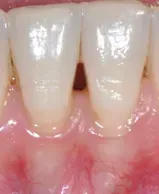
PRE-TREATMENT
The photo above shows gingival recession with thin tissue and no protective zone of attached tissue below the root structure. The lip is directly attached to the roots and recession will continue to progress if no treatment is performed.

POST-TREATMENT
A free gingival graft has been placed below the exposed root structure to provide thickness and added protection from future recession.
Minimally Invasive Root Coverage

PRE-TREATMENT
PURPOSE
Gingival recession is defined as a mucogingival deformity and condition that results in exposure of root surface. The main consequences of gingival recession include:
- Root sensitivity
- Esthetic concerns
- Loss of periodontal support
- Increased risk of root decay
If your periodontist has decided that you have no protective zone of attached tissue beneath the root structure, a free gingival graft will be treatment planned.
A free gingival graft is a thin piece of tissue taken from the roof of your mouth to be placed beneath the area of recession. The purpose is to thicken the underlying thin tissue and to prevent future recession.
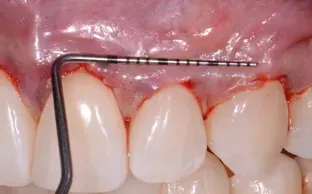
DURING TREATMENT
PROCEDURE DETAILS
- Approximately 1-2 hours of surgical time with the use of a local anesthetic.
- First, a thin tunnel is created beneath the exposed roots to allow for stretching of the gum tissue.
- A donor tissue graft is then carefully placed within the tunnel.
- Finally, the tunnel and donor tissue is positioned over the exposed roots and sutured in place.
- You will return for a post-operative visit in two weeks to check on healing and reinstruct oral hygiene.
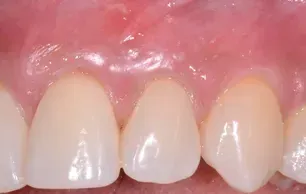
POST-TREATMENT
RECOVERY TIME
Approximately 2-3 days. Every patient differs on level of discomfort depending on the extent of the graft site.
Frenectomies

The frenum (or muscle) attachment has created a separation (or diastema) between the front teeth.
PRE-TREATMENT
PURPOSE
A naturally occurring muscle attachment normally seen between the front teeth (upper or lower) is called a frenum. Any combination of thin tissue, lack of attached tissue, or muscle pull may cause gingival recession to occur. A large frenum may even prevent teeth from joining harmoniously together. A frenectomy is removal and release of this muscle attachment in order to assist in avoiding future recession and gaps between teeth.
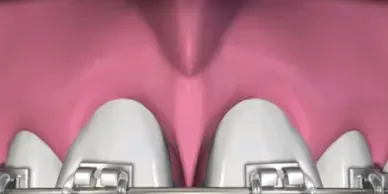
The frenum attachment has been removed and braces placed.
DURING TREATMENT
PROCEDURE DETAILS
- 15-30 minutes with the use of a local anesthetic.
- The surgical release is either performed with a small incision or the use of a laser. Your periodontist will decide which treatment option is best for you.
- A post-operative visit will be scheduled at two weeks post-frenectomy to observe the healing and reinstruct oral hygiene.
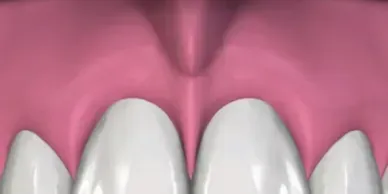
POST-TREATMENT
RECOVERY TIME
Approximately 1 day.
Learn More about Periodontal Services
- Scaling and Root Planing
- Osseous Surgery
- Laser Therapy
- Crown Lengthening
- Soft Tissue Grafting
- Extractions/Bone Grafting
- Orthodontic Exposures
- Platelet-Rich Therapy
- Teeth Cleaning
- Periodontal Maintenance
Please contact us with any questions you may have.
Paradise Periodontics provides exceptional periodontal care to the Sarasota community.
BROWSE OUR SITE
Paradise Periodontics. All rights reserved.
